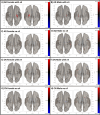Sex differences in interacting genetic and functional connectivity biomarkers in Alzheimer's disease
- PMID: 38598069
- PMCID: PMC11493897
- DOI: 10.1007/s11357-024-01151-x
Sex differences in interacting genetic and functional connectivity biomarkers in Alzheimer's disease
Abstract
As of 2023, it is estimated that 6.7 million individuals in the United States live with Alzheimer's disease (AD). Prior research indicates that AD disproportionality affects females; females have a greater incidence rate, perform worse on a variety of neuropsychological tasks, and have greater total brain atrophy. Recent research shows that hippocampal functional connectivity differs by sex and may be related to the observed sex differences in AD, and apolipoprotein E (ApoE) ε4 carriers have reduced hippocampal functional connectivity. The purpose of this study was to determine if the ApoE genotype plays a role in the observed sex differences in hippocampal functional connectivity in Alzheimer's disease. The resting state fMRI and T2 MRI of individuals with AD (n = 30, female = 15) and cognitively normal individuals (n = 30, female = 15) from the Alzheimer's Disease Neuroimaging Initiative (ADNI) were analyzed using the functional connectivity toolbox (CONN). Our results demonstrated intrahippocampal functional connectivity differed between those without an ε4 allele and those with at least one ε4 allele in each group. Additionally, intrahippocampal functional connectivity differed only by sex when Alzheimer's participants had at least one ε4 allele. These results improve our current understanding of the role of the interacting relationship between sex, ApoE genotype, and hippocampal function in AD. Understanding these biomarkers may aid in the development of sex-specific interventions for improved AD treatment.
Keywords: Alzheimer’s disease (AD); Apolipoprotein E; Functional connectivity; Sex difference.
© 2024. The Author(s), under exclusive licence to American Aging Association.
Conflict of interest statement
The authors declare no competing interests.
Figures




References
-
- Alzheimer's Association. 2023 Alzheimer’s disease facts and figures. Alzheimers Dement. 2023;19(4):1598–95. - PubMed
-
- National Institute of Health. Alzheimer’s disease. 2021. Available from https://www.nih.gov/research-training/accelerating-medicines-partnership.... Accessed 30 Jan 2023.
-
- Alzheimer's Association. 2022 Alzheimer’s disease facts and figures. Alzheimers Dement. 2022;18(4):700–89. - PubMed
-
- National Institute on Aging. What happens to the brain in Alzheimer’s disease? National Institute on Aging; 2017.
MeSH terms
Substances
Grants and funding
LinkOut - more resources
Full Text Sources
Medical
Research Materials
Miscellaneous

